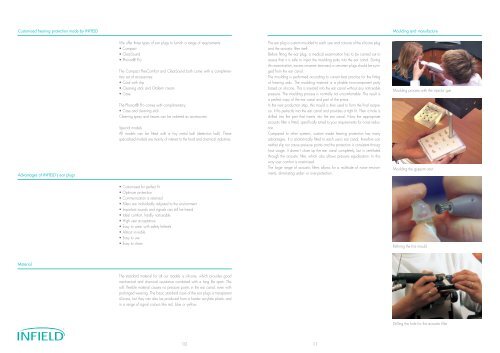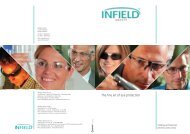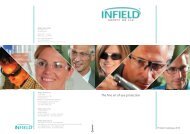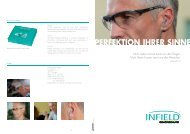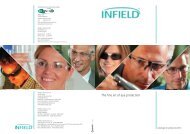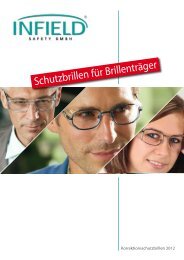Infield Gehoer 16-S GB - infield-safety
Infield Gehoer 16-S GB - infield-safety
Infield Gehoer 16-S GB - infield-safety
Create successful ePaper yourself
Turn your PDF publications into a flip-book with our unique Google optimized e-Paper software.
Customised hearing protection made by INFIELD<br />
Advantages of INFIELD’s ear plugs<br />
Material<br />
We offer three types of ear plugs to furnish a range of requirements:<br />
• Compact<br />
•ClearSound<br />
• Phonor® Pro<br />
The Compact FlexComfort and ClearSound both come with a complimentary<br />
set of accessories:<br />
•Cord with clip<br />
•Cleaning stick and Otoferm cream<br />
• Case<br />
The Phonor® Pro comes with complimentary:<br />
•Case and cleaning stick<br />
Cleaning spray and tissues can be ordered as accessories.<br />
Special models<br />
All models can be fitted with a tiny metal ball (detection ball). These<br />
specialised models are mainly of interest to the food and chemical industries.<br />
•Customised for perfect fit<br />
• Optimum protection<br />
•Communication is retained<br />
• Filters are individually adjusted to the environment<br />
•Important sounds and signals can still be heard<br />
•Ideal comfort, hardly noticeable<br />
•High user acceptance<br />
• Easy to wear with <strong>safety</strong> helmets<br />
• Almost invisible<br />
• Easy to use<br />
• Easy to clean<br />
The standard material for all our models is silicone, which provides good<br />
mechanical and chemical resistance combined with a long life span. The<br />
soft, flexible material causes no pressure points in the ear canal, even with<br />
prolonged wearing. The basic standard issue of the ear plugs is transparent<br />
silicone, but they can also be produced from a harder acrylate plastic and<br />
in a range of signal colours like red, blue or yellow.<br />
10 11<br />
The ear plug is custom moulded to each user and consists of the silicone plug<br />
and the acoustic filter itself.<br />
Before fitting the ear plug, a medical examination has to be carried out to<br />
assess that it is safe to inject the moulding putty into the ear canal. During<br />
this examination, excess cerumen (earwax) or cerumen plugs should be syringed<br />
from the ear canal.<br />
The moulding is performed according to current best practice for the fitting<br />
of hearing aids. The moulding material is a pliable two-component putty<br />
based on silicone. This is injected into the ear canal without any noticeable<br />
pressure. The moulding process is normally not uncomfortable. The result is<br />
a perfect copy of the ear canal and part of the pinna.<br />
In the next production step, this mould is then used to form the final earpiece.<br />
It fits perfectly into the ear canal and provides a tight fit. Then a hole is<br />
drilled into the part that inserts into the ear canal. Now the appropriate<br />
acoustic filter is fitted, specifically tuned to your requirements for noise reduction.<br />
Compared to other systems, custom made hearing protection has many<br />
advantages. It is anatomically fitted to each user’s ear canal, therefore can<br />
neither slip nor cause pressure points and the protection is consistent throughout<br />
usage. It doesn’t close up the ear canal completely, but is ventilated<br />
through the acoustic filter, which also allows pressure equalisation. In this<br />
way user comfort is maximised.<br />
The large range of acoustic filters allows for a multitude of noise environments,<br />
eliminating under- or over-protection.<br />
Moulding and manufacture<br />
Moulding process with the injector gun<br />
Moulding the gypsum cast<br />
Refining the first mould<br />
Drilling the hole for the acoustic filter


